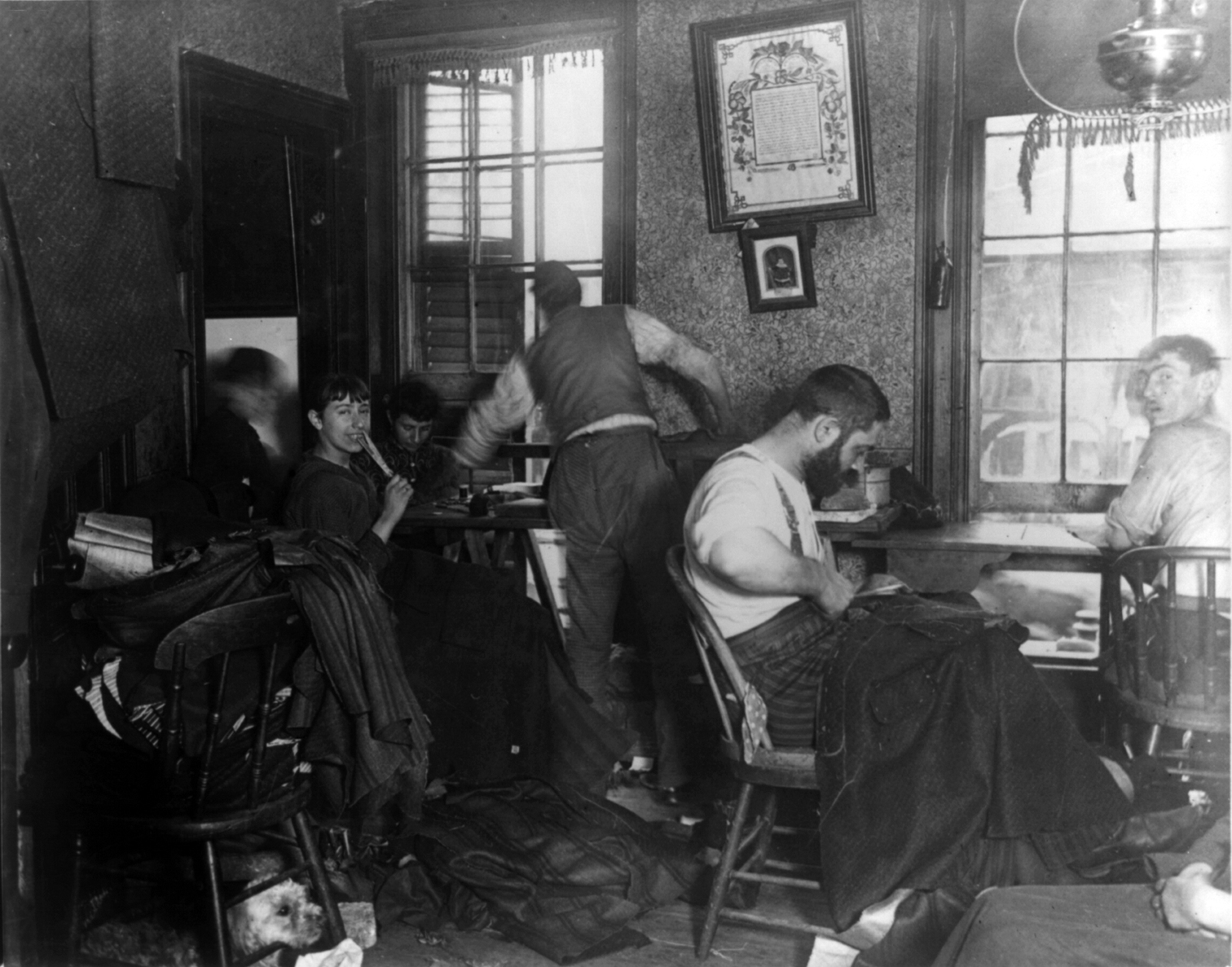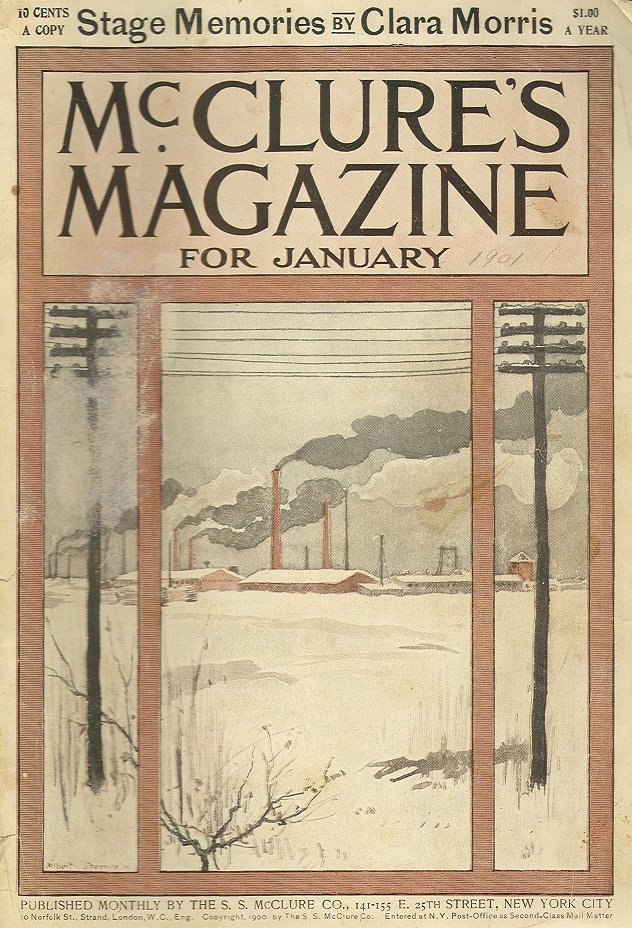|
Sweatshop
A sweatshop or sweat factory is a crowded workplace with very poor, socially unacceptable or illegal working conditions. Some illegal working conditions include poor ventilation, little to no breaks, inadequate work space, insufficient lighting, or uncomfortably/dangerously high or low temperatures. The work may be difficult, tiresome, dangerous, climatically challenging or underpaid. Workers in sweatshops may work long hours with unfair wages, regardless of laws mandating overtime pay or a minimum wage; child labor laws may also be violated. Women make up 85 to 90% of sweatshop workers and may be forced by employers to take birth control and routine pregnancy tests to avoid supporting maternity leave or providing health benefits. The Fair Labor Association's "2006 Annual Public Report" inspected factories for FLA compliance in 18 countries including Bangladesh, El Salvador, Colombia, Guatemala, Malaysia, Thailand, Tunisia, Turkey, China, India, Vietnam, Honduras, Indonesia, Brazil ... [...More Info...] [...Related Items...] OR: [Wikipedia] [Google] [Baidu] |
Minimum Wage
A minimum wage is the lowest remuneration that employers can legally pay their employees—the price floor below which employees may not sell their labor. Most countries had introduced minimum wage legislation by the end of the 20th century. Because minimum wages increase the cost of labor, companies often try to avoid minimum wage laws by using gig workers, by moving labor to locations with lower or nonexistent minimum wages, or by automating job functions. The movement for minimum wages was first motivated as a way to stop the exploitation of workers in sweatshops, by employers who were thought to have unfair bargaining power over them. Over time, minimum wages came to be seen as a way to help lower-income families. Modern national laws enforcing compulsory union membership which prescribed minimum wages for their members were first passed in New Zealand in 1894. Although minimum wage laws are now in effect in many jurisdictions, differences of opinion exist about the ben ... [...More Info...] [...Related Items...] OR: [Wikipedia] [Google] [Baidu] |
Piecework
Piece work (or piecework) is any type of employment in which a worker is paid a fixed piece rate for each unit produced or action performed, regardless of time. Context When paying a worker, employers can use various methods and combinations of methods. Some of the most prevalent methods are: paid a wage by the hour (known as "time work"); paid an annual salary; salary plus commission (common in sales jobs); base salary or hourly wages plus gratuities (common in service industries); salary plus a possible bonus (used for some managerial or executive positions); salary plus stock options (used for some executives and in start-ups and some high tech firms); salary pool systems; gainsharing (also known as "profit sharing"); paid by the piece – the number of things they make, or tasks they complete (known as ‘output work’); or paid in other ways (known as ‘unmeasured work’). Some industries where piece rate pay jobs are common are agricultural work, cable installation, c ... [...More Info...] [...Related Items...] OR: [Wikipedia] [Google] [Baidu] |
International Ladies' Garment Workers' Union
The International Ladies' Garment Workers' Union (ILGWU), whose members were employed in the women's clothing industry, was once one of the largest labor unions in the United States, one of the first U.S. unions to have a primarily female membership, and a key player in the labor history of the 1920s and 1930s. The union, generally referred to as the "ILGWU" or the "ILG", merged with the Amalgamated Clothing and Textile Workers Union in the 1990s to form the Union of Needletrades, Industrial and Textile Employees ( UNITE). UNITE merged with the Hotel Employees and Restaurant Employees Union (HERE) in 2004 to create a new union known as UNITE HERE. The two unions that formed UNITE in 1995 represented 250,000 workers between them, down from the ILGWU's peak membership of 450,000 in 1969. Early history The ILGWU was founded on June 3, 1900, in New York City by seven local unions, with a few thousand members between them. The union grew rapidly in the next few years but began t ... [...More Info...] [...Related Items...] OR: [Wikipedia] [Google] [Baidu] |
National Anti-Sweating League
The National Anti-Sweating League is the name adopted by two groups of social reformers in Australia and Britain at the turn of the nineteenth and twentieth centuries. Both campaigned against the poor conditions endured by many workers in so-called sweatshops and called for a minimum wage. Australia The National Anti-Sweating League was inaugurated in Melbourne on 29 Jul 1895, with Rev. A. Gosman as president, Samuel Mauger as secretary, and Alfred Deakin as treasurer.Race Mathews (1993) ''Australia's First Fabians: Middle-class Radicals, Labour Activists and the Early Labour Movement'' Cambridge University Press Vida Goldstein was another member.Lees, Kirsten (1995) ''Votes for Women: The Australian Story'' St. Leonards: Allen & Unwin, p. 145 Their efforts resulted in wage regulation via the Factory Act of 1896.Sheila Blackburn (1991) ''The Historical Journal'' 34 (1) 43-64 "Ideology and Social Policy: The Origins of the Trade Boards Act" Britain The National Anti-Sweatin ... [...More Info...] [...Related Items...] OR: [Wikipedia] [Google] [Baidu] |
Triangle Shirtwaist Factory Fire
The Triangle Shirtwaist Factory fire in the Greenwich Village neighborhood of Manhattan, New York City, on Saturday, March 25, 1911, was the deadliest industrial disaster in the history of the city, and one of the deadliest in U.S. history. The fire caused the deaths of 146 garment workers – 123 women and girls and 23 men – who died from the fire, smoke inhalation, or falling or jumping to their deaths. Most of the victims were recent Italian or Jewish immigrant women and girls aged 14 to 23; of the victims whose ages are known, the oldest victim was 43-year-old Providenza Panno, and the youngest were 14-year-olds Kate Leone and Rosaria "Sara" Maltese. The factory was located on the 8th, 9th, and 10th floors of the Asch Building, which had been built in 1901. Later renamed the " Brown Building", it still stands at 23–29 Washington Place near Washington Square Park, on the New York University (NYU) campus. The building has been designated a National Historic Landmark and a ... [...More Info...] [...Related Items...] OR: [Wikipedia] [Google] [Baidu] |
How The Other Half Lives
''How the Other Half Lives: Studies among the Tenements of New York'' (1890) is an early publication of photojournalism by Jacob Riis, documenting squalid living conditions in New York City slums in the 1880s. The photographs served as a basis for future " muckraking" journalism by exposing the slums to New York City's upper and middle classes. They inspired many reforms of working-class housing, both immediately after publication as well as making a lasting impact in today's society. Background 19th century, New York City In the 1880s many people in upper- and middle-class society were unaware of the dangerous conditions in the slums among poor immigrants. After the Civil War, the country transformed into an industrial superpower and became largely urban. Also, a wave of unskilled southern European, eastern European, Asian, and Jewish immigrants came to settle in the "promised land" of the United States. This migration was vastly different from the previous booms due to the in ... [...More Info...] [...Related Items...] OR: [Wikipedia] [Google] [Baidu] |
Labor Laws
Labour laws (also known as labor laws or employment laws) are those that mediate the relationship between workers, employing entities, trade unions, and the government. Collective labour law relates to the tripartite relationship between employee, employer, and union. Individual labour law concerns employees' rights at work also through the contract for work. are social norms (in some cases also technical standards) for the minimum socially acceptable conditions under which employees or contractors are allowed to work. Government agencies (such as the former US Employment Standards Administration) enforclabour law(legislature, regulatory, or judicial). History Following the unification of the city-states in Assyria and Sumer by Sargon of Akkad into a single empire ruled from his home city circa 2334 BC, common Mesopotamian standards for length, area, volume, weight, and time used by artisan guilds in each city was promulgated by Naram-Sin of Akkad (c. 2254–2218 ... [...More Info...] [...Related Items...] OR: [Wikipedia] [Google] [Baidu] |
Child Labor
Child labour refers to the exploitation of children through any form of work that deprives children of their childhood, interferes with their ability to attend regular school, and is mentally, physically, socially and morally harmful. Such exploitation is prohibited by legislation worldwide, although these laws do not consider all work by children as child labour; exceptions include work by child artists, family duties, supervised training, and some forms of work undertaken by Amish children, as well as by indigenous children in the Americas. Child labour has existed to varying extents throughout history. During the 19th and early 20th centuries, many children aged 5–14 from poorer families worked in Western nations and their colonies alike. These children mainly worked in agriculture, home-based assembly operations, factories, mining, and services such as news boys – some worked night shifts lasting 12 hours. With the rise of household income, availability of s ... [...More Info...] [...Related Items...] OR: [Wikipedia] [Google] [Baidu] |
Meat Packing Industry
The meat-packing industry (also spelled meatpacking industry or meat packing industry) handles the slaughtering, processing, packaging, and distribution of meat from animals such as cattle, pigs, sheep and other livestock. Poultry is generally not included. This greater part of the entire meat industry is primarily focused on producing meat for human consumption, but it also yields a variety of by-products including hides, dried blood, protein meals such as meat & bone meal, and, through the process of rendering, fats (such as tallow). In the United States and some other countries, the facility where the meat packing is done is called a ''slaughterhouse'', ''packinghouse'' or a ''meat-packing plant''; in New Zealand, where most of the products are exported, it is called a ''freezing works''. An abattoir is a place where animals are slaughtered for food. The meat-packing industry grew with the construction of the railroads and methods of refrigeration for meat preservatio ... [...More Info...] [...Related Items...] OR: [Wikipedia] [Google] [Baidu] |
Muckraker
The muckrakers were reform-minded journalists, writers, and photographers in the Progressive Era in the United States (1890s–1920s) who claimed to expose corruption and wrongdoing in established institutions, often through sensationalist publications. The modern term generally references investigative journalism or watchdog journalism; investigative journalists in the US are occasionally called "muckrakers" informally. The muckrakers played a highly visible role during the Progressive Era. Muckraking magazines—notably '' McClure's'' of the publisher S. S. McClure—took on corporate monopolies and political machines, while trying to raise public awareness and anger at urban poverty, unsafe working conditions, prostitution, and child labor. Most of the muckrakers wrote nonfiction, but fictional exposés often had a major impact, too, such as those by Upton Sinclair. In contemporary American usage, the term can refer to journalists or others who "dig deep for the facts" o ... [...More Info...] [...Related Items...] OR: [Wikipedia] [Google] [Baidu] |
The Jungle
''The Jungle'' is a 1906 novel by the American journalist and novelist Upton Sinclair. Sinclair's primary purpose in describing the meat industry and its working conditions was to advance socialism in the United States. However, most readers were more concerned with several passages exposing health violations and unsanitary practices in the American meat packing industry during the early 20th century, which greatly contributed to a public outcry that led to reforms including the Federal Meat Inspection Act, Meat Inspection Act. The book depicts working-class poverty, lack of social supports, harsh and unpleasant living and working conditions, and hopelessness among many workers. These elements are contrasted with the deeply rooted Political corruption, corruption of people in power. A review by the writer Jack London called it "the ''Uncle Tom's Cabin'' of wage slavery." Sinclair was considered a muckraker, a journalist who exposed corruption in government and business. In 190 ... [...More Info...] [...Related Items...] OR: [Wikipedia] [Google] [Baidu] |







